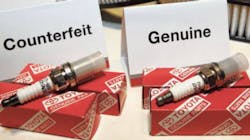There has been a marked increase in the prevalence of counterfeit parts, particularly with electronic components – from simple components to complex integrated circuits. The number of counterfeit parts incidents over the last three years has tripled.
The FBI estimates that U.S. businesses lose some $250 billion to counterfeiting on an annual basis. The Motor and Equipment Manufacturers Association (MERA), attributing information from the Federal Trade Commission, has estimated that the U.S. automotive parts industry has lost $3 billion in sales due to counterfeit goods.
Sources
Where do these bogus parts come from? China is the largest source of all counterfeit items. Trade figures show approximately 80 percent of all bogus items in all industries come from China.
There is enough profit in counterfeit parts to start to be attractive to organized crime. Two aspects make this particularly attractive:
- Very short, if any, jail time if you get caught.
- The spare parts business already has enormous margins, so “doing the time” can be worth it.
Red Flags
What products are most susceptible to counterfeiting? Among those are parts that:
- Are expensive, due to a brand name – think CAT parts.
- Need a registration or excessive paperwork to prove authenticity – think aircraft parts.
There are tell-tale signs that can easily be used to help spot the imitation from the real thing. Automotive parts provider ACDelco offers these:
- Significant price differences. “Be careful when dealing with suppliers offering prices that are significantly lower than what you usually pay,” advise ACDelco officials.
- Unconventional supplier. “Do business with reputable companies. When dealing with suppliers from whom you don't usually buy, proceed with caution.”
- Questionable quality. “Closely examine the parts you buy. Look for variations in size, shape and texture from originals you've used before.”
- Packaging variations. “Make sure the graphics and colors of the box are identical to those you're used to seeing.”
- Installation problems. “If a part doesn't fit exactly as it should, it could be a fake.”
Victims
In some cases, the end user – your company – is a victim of the counterfeiter. In other cases, your firm might just have itself to blame. When the vendor is shady, the price is too low, etc., you might suspect the parts are fake yet someone turns a blind eye because the deal is too tempting to pass up.
Counterfeiting is a crime. But unlike bootlegging music or movies, there could be catastrophic consequences with counterfeit parts. At the very least, a company that uses the fakes could suffer shorter asset life.
Not Going Away
As long as there is money to be made by people without ethics, there will be counterfeiters and, unfortunately, they are only getting better at what they do.
As counterfeiting increases, both suppliers and customers must be informed and vigilant. It is critical that parts dispositioned as counterfeit are reported and quarantined so that they do not re-enter the supply chain.
Classic reliability testing methods coupled with conventional quality control inspection methodologies are the key to enhancing and optimizing your company’s supply chain through the reduction of counterfeit parts.
Take a proactive approach to reducing your risk by implementing a counterfeit parts quality control plan that integrates conventional reliability methods.
Joel Levitt is director of projects for Reliabilityweb.com’s Reliability Leadership Institute. Reliabilityweb.com provides the latest reliability and uptime maintenance news and educational information.
About the Author

Joel Levitt
President, Springfield Resources
Joel Levitt has trained more than 17,000 maintenance leaders from more than 3,000 organizations in 24 countries. He is the president of Springfield Resources, a management consulting firm that services a variety of clients on a wide range of maintenance issues www.maintenancetraining.com. He is also the designer of Laser-Focused Training, a flexible training program that provides specific targeted training on your schedule, online to one to 250 people in maintenance management, asset management and reliability.
